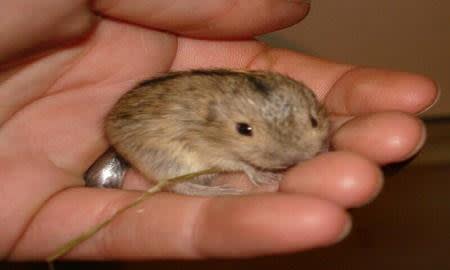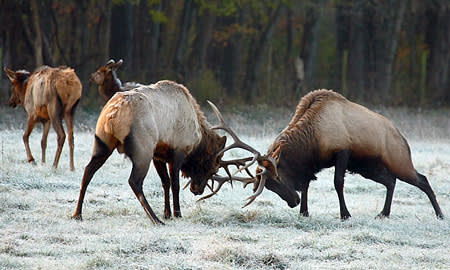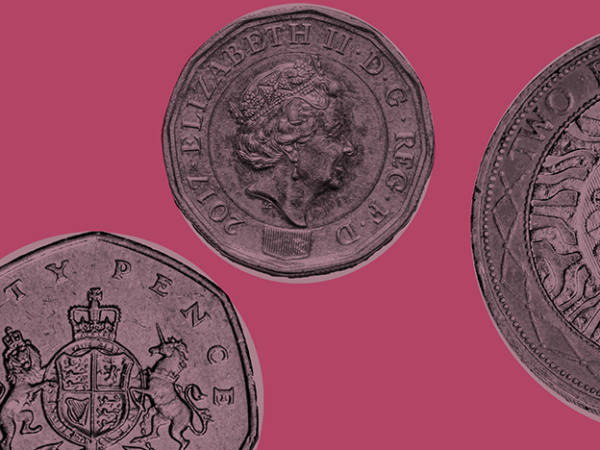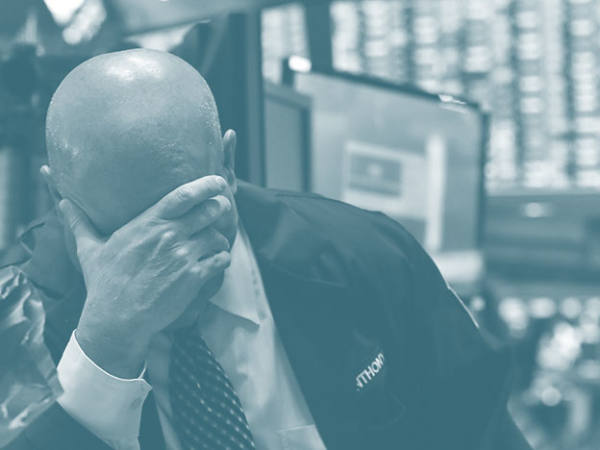In this sense, economists are merely reclaiming one of their own ideas: Darwin borrowed the theory of natural selection from the economist Thomas Malthus.
To some extent, there's nothing new in this. Economists have long argued that their apparently silly idea that companies and people rationally maximise their self-interest makes sense only as the outcome of natural selection. The late Milton Friedman said that irrational, destabilising speculation could not persist because speculators who bought overpriced assets - thus driving their prices even higher - would lose money and so leave the market. Darwinian selection would kill them off.
However, economists now know that Friedman was only partially right. Selection is a powerful force. But it does not necessarily swiftly weed out the stupid money.
Survival of the stupid
Bernard Dumas, an economist at INSEAD in Fontainebleau, points out one reason for this. To trade against irrational investors, rational investors must know more than merely that a share is over- or underpriced. They must know that the overconfident investors who drove its price up (or down) will not push it up even further. But they generally can't know this. Such uncertainty will limit the extent to which they go short of the overpriced share and long of under-priced ones. Their lack of activity will then keep shares mis-priced and so allow lots of irrational and mistaken traders to make money. Professor Dumas says: "Even a moderate-sized group of overconfident investors may do a lot of damage and survive for a long time before being driven out of the market by rational investors."
Brock Mendel and Andrei Shleifer, two Harvard economists, say the problem can be even worse than this - because the smart money might sometimes actually trade on the same side as the stupid money. Consider a market in which there are three species of trader: rational, informed insiders; rational outsiders who lack information but must infer it from price behaviour; and noise traders who buy or sell as sentiment changes. Rational outsiders will want to trade on the same side as insiders - buying when they buy and selling when they sell - and on the opposite side to noise traders. But the problem is that they cannot tell which is which. Sometimes, therefore, they might trade on the same side as the noise traders, buying when they (wrongly) buy. Such trading amplifies volatility and, again, allows irrational traders to make profits and survive.
Selection, then, favours the stupid money and works against rational, informed investors.
This is no mere textbook possibility. Dr Mendel says it is just what happened in 2007, when banks took on lots of disastrous credit risk. Investors who didn't know the true risks of collateralised debt obligations and credit default swaps interpreted their low spreads over government bonds as a sign that informed opinion thought that credit risk was low. So they bought. The problem was that it was not informed opinion that was driving the market, but rather irrational sentiment.
These are stories in which selection doesn't operate especially powerfully and might actually back-fire. You might think, however, that if competitive pressures were severe, then they would indeed wipe out the stupid money.
But you'd be wrong. Imagine two investment strategies. Strategy one has as expected return of 10 per cent a year with a standard deviation of 10 percentage points. Strategy two has an expected return of 5 per cent with a standard deviation of 20 percentage point. You can think of strategy one as being a well-diversified portfolio of under-priced stocks, while strategy two is a rag-bag of volatile but expensive speculative plays.
It's obvious that strategy one is the best, in the sense of having higher expected returns and lower volatility. But it will not necessarily be the one that gets selected by competition.
Imagine that only strategies that earn a return of 20 per cent or more get selected. Strategy two has a better chance of surviving than strategy one: a three-quarter standard deviation chance (22.7 per cent) versus a one standard deviation chance (15.9 per cent) to be precise. Selection thus favours the worse strategy. Bjorn-Christopher Witte of the University of Bamberg says: "In the extreme cases, survivors are not the most skilled but simply the luckiest risk-seekers."
What about 'survival of the fittest'? This, says Dr Witte, is a trivial tautology; it is the fittest who survive, by definition. The question is: what exactly is 'fittest'? It is not necessarily the cleverest or most rational.
Take, for example, the buying of unit trusts. If investors look for good past performing funds, they will be attracted to the lucky risk-seekers, driving more cautious managers out of work.
This is no mere theoretical possibility. In the late 1990s, the late Tony Dye, chief investment officer at Phillips & Drew, avoided tech stocks believing them to be overpriced and held "old economy" shares instead. He underperformed the market and was sacked in 2000 - just before his strategy was vindicated. He was a 'strategy one' investor who lost out to 'strategy two' players - those who bought overpriced volatile stocks.
Another example comes from the 2008 crisis. In July 2007, Charles Prince, then chief executive of Citigroup, defended his company's risky investment policy by saying "as long as the music is playing, you've got to get up and dance. We're still dancing". He saw that competitive pressures - the 'music' - at the time were selecting for risk-taking behaviour. Only now do we know that such behaviour was deadly.
How bubbles evolve
These two episodes have something else in common. Both occurred during what we now know to be bubbles. This is no accident. One reason why bubbles persist is that as prices rise the market selects in favour of risk-taking strategies (species) and against cautious ones, with the result that risk-taking species multiply, which in turn drives prices higher.
It's not just in obvious big bubbles that such selection happens. The late Hyman Minsky argued that macroeconomic stability was inherently self-destroying. Good times and economic stability, he said, encourage people, companies and banks to take on more debt and more speculative investments, which eventually causes a crash. This fits the story of Darwinian selection well; economic stability selects for risk-taking behaviour, which in turn multiplies, and in turn causes the disasters associated with over-population. It also, of course, fits the fact that the 'Great Moderation' of the 90s and early 00s ended in a slump.
This draws attention to another parallel between markets and biology. Many species undergo population cycles - they cycle between being scarce and abundant. Similarly, in financial markets, risk-taking 'species' cycle between being abundant (in the mid-00s) and scarce (now).
Cyclical markets
In both cases, there's a similar mechanism at work - the interaction of population and food. Take the Alaskan lemming. When its food - moss and plant shoots - is abundant, the number of lemmings grows. But beyond a certain point, lemmings become so common that they eat all the food, with the result that many starve to death. And as the lemming population falls, the pressure on food diminishes, and so plants and moss regrow. That allows more lemmings to feed and breed, and so the lemming cycle begins again.
The same thing happens in financial markets, with the food source being profits and the lemmings being trading strategies. If there are lots of profits relative to the number of traders using a particular strategy, those traders make lots of money, which attracts others to follow them. The strategy, like the lemming population, multiplies. But as it multiplies, the profits get bid away. The strategy then becomes unfashionable - as some of its users lose money and exit the market.
For example, in the early 1980s, economists pointed out that smaller stocks tended to outperform over the long run. This led to a growth in the population of 'buy small caps' strategies: small-cap investment and unit trusts multiplied. This caused over-feeding, with the result that the food source for the strategies disappeared; for most of the 90s, small caps underperformed. But by the late 90s, interest in the small-cap strategy had fallen so low that the food source was abundant relative to the species, with the result that in the following few years the species did well.
For another example, take momentum trading in currencies. Lucio Sarno of Cass Business School has shown that this works well on average over the long run. But its profits are cyclical. In 2001-02 the strategy lost money. Those who used it therefore left the market - they either changed strategy or lost their jobs. This meant that momentum trading would have made huge profits in the mid-2000s, as the food source became abundant relative to the population living off it.
Competition costs
There's another way in which the evolutionary perspective on markets warns us that competition need not lead us to a socially beneficial outcome. Cornell University's Robert H Frank points to bull elk. These have evolved huge antlers. This is because an individual with them is more likely to win a fight against other elk and so get access to females, and thus pass on big antlers to his descendants. For each individual elk, big antlers maximise fitness, in the sense of increasing the chances of having descendants. However, for elk as a species, big antlers are a nuisance as they slow the elk down and so make them more likely to be killed by wolves. Competition between elk, therefore, produces an outcome that is bad for all elk. It would be better for the species if all had smaller antlers, but there's just no way of organising this.
Professor Frank thinks this sort of socially sub-optimal competition is common in economics. He believes it causes people to spend too much on big cars and houses as they try to keep up with, or get one over on, the Joneses.
It can also matter for investors. The Bank of England's Andrew Haldane has described banks' increasing borrowing in the 1990s and 00s as a "financial arms race", comparable with the elk's development of big antlers. Each individual bank wanted to exceed its rivals' return on equity. It did so by increasing its leverage. The upshot was that the banking system as a whole became dangerously over-leveraged. Mr Haldane said: "Systems, both social and natural, are characterised by a survival of the fittest. But, for both, that competitive race can at times generate unhealthy outcomes for the system as a whole."
It's not just such arms races that can lead to aggregate instability. So too can ordinary maximising behaviour. Andrew Lo of the Massachusetts Institute of Technology explains why. Say you have a choice between two strategies. One has a 60 per cent chance of a pay-off of three and a 40 per cent chance of a zero pay-off. The other has a 40 per cent chance of a pay-off of three and a 60 per cent chance of a zero pay-off. Obviously, the first strategy has the higher expected pay-off. It's the one that rational people would choose.
But what if the pay-offs are the number of descendants you have? The first time that 40 per cent chance comes up, all species following the first strategy will go extinct. Survival requires species not to maximise the expected pay off, but to follow a mixed strategy.
But competition in good times selects against mixed strategies. Mr Haldane says this is what happened to banks during the 90s and early 00s. Almost all became over-geared. And when disaster struck, the collapse of one meant the collapse of many, as banks stopped lending to each other and were left with mortgage derivatives on their books that were impossible to sell. During the good times, each individual bank thought it safest to do what other banks were doing. But this just increased the risks to banks as a whole. "Financial ecosystems are like biological ones," says Mr Haldane. Just as an environmental disaster can wipe out a biological ecosystem that is insufficiently diversified, so too can it can wipe out a homogenous financial system.
The Darwinian investor
So, what should the Darwinian investor do?
One thing is what we should do anyway - diversify. Evolutionary theory tells us that mixed strategies are often the key to survival.
Secondly, we should forget the hoary old question: are markets efficient or not? Efficiency varies from time to time. Sometimes, food (profits) will be scarce and so markets will appear efficient, in the sense that you can't earn good returns without taking risk. But sometimes, food will be abundant and markets inefficient. Professor Lo says we should think of markets as constantly adapting. The profitability of investment strategies, he says, "will wax and wane".
Thirdly, we should remember that natural selection operates in two different ways. For concreteness, take the bull market in government bonds. Two mechanisms are at work here.
First, there's selection in favour of bond-buying strategies. Investors who shunned bonds, fearing inflation or whatever, have lost money while bond bulls have made it and have bigger money to reinvest in the market. This mechanism points to bond prices rising.
Secondly, there's competition for food. If lots species are competing for a food source, that source will eventually become depleted and so the species will die out. Likewise, if lots of strategies chase a particular source of profits, those profits will be slim and so some strategies will die.
In the early stages of a bull market, the first mechanism dominates. But as the bull market matures and then dies, the second mechanism becomes more powerful. The question to ask before buying any asset is: is the first mechanism stronger than the second? If it is, you should buy. If it isn't, you shouldn't.
But how can we tell? Here's another problem. Very often, we can't. There's another fact about evolution - no species ever foresaw its extinction. Just as dinosaurs never saw their demise coming, nor did tech investors in 1999 foresee the bursting of the bubble, nor bankers the collapse of banks. Evolution, says Professor Richard Dawkins, "is blind to the future".













